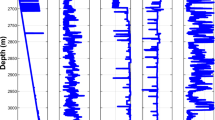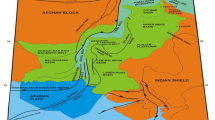Abstract
Geophysical well-log (bore-hole) data facilitate understanding of the physical properties of the subsurface formations as a function of depth measured in a well. In the present study, the wavelet transformation technique was applied to the well-log data of three wells in the Bombay High oil field, India, in order to identify depths to the tops of oil and/or gas formation zones (pay zones). Continuous wavelet transformation (CWT) was performed on gamma-ray, resistivity, neutron porosity and velocity log data sets in order to determine the space-localization of the oil and/or gas formation zones. The choice of a mother wavelet is important and largely depends on the data under investigation. We have applied a variety of wavelets to the different log data sets to not only identify the depths to the tops of formation zones, but also to determine the optimum wavelet that best characterizes the pay zones. On examination of scalogram plots of each log corresponding to each wavelet for their better resolution in identifying the formation boundaries, we have found that the scalograms corresponding to the Gaus1 wavelet appeared to give the best resolution in identifying the depths of pay zones in all the well-log data sets of all three wells. To further validate the above observation, a histogram analysis of CWT coefficients is made. This showed that, of all the wavelets considered for the present study, Gaus1 wavelet is the most appropriate and optimum for determining the space-localization of pay zones in all the well-log data sets considered in the present study. The depths of pay zones estimated from scalogram plots of logs agree well with those provided by the Oil and Natural Gas Corporation Ltd., India.





















Similar content being viewed by others
References
Anxionnaz H, Delfiner P, Delhomme JP (1990) Computer-generated core-like descriptions from open-hole logs. Am Assoc Pet Geol Bull 74:375–393
Bhandari LL, Jain SK (1984) Reservoir geology and its role in the development of the L-III reservoir, Bombay high field. Indian J Pet Geol 7:27–46
Biswas SK (1982) Rift basins in western margin of India and their hydrocarbon prospects with special reference to Kutch Basin. Am Assoc Pet Geol Bull 66:1497–1513
Choudhury S, Chandrasekhar E, Pandey VK, Prasad M (2007) Use of wavelet transformation for geophysical well-log data analysis. IEEE Xplore. doi:10.1109/ICDSP.2007.4288665
Daubechies I (1992) Ten lectures on wavelets. SIAM, Philadelphia
Gadre VM (2011) Wavelets and multirate digital signal processing: time–bandwidth product. Video lecture, Dept. of Electrical Engineering, IIT, Bombay. URL. http://www.youtube.com/watch?v=zYVWe6ENk9w
Jansen FE, Kelkar M (1997) Application of wavelets to production data in describing inter-well relationships. In: Soc Petr Engr # 38876: annual technical conference and exhibition. San Antonio, TX, October 5–8, 1997
Jennings JW, Ruppel SC, Ward WB (2000) Geostatistical analysis of permeability data and modeling of fluid-flow effects in carbonate outcrops. SPE Reserv Eval Eng 3:292–303
Kumar P, Foufoula-Georgiou E (1994) Wavelet analysis in geophysics: an introduction. In: Foufoula-Georgiou E, Kumar P (eds) Wavelets in geophysics. Academic Press, San Diego, pp 1–43
Ma K, Tang X (2001) Translation-invariant face feature estimation using discrete wavelet transform. In: Tang YY, et al (eds) Proceedings of the second international conference on wavelet analysis and its applications. LNCS, vol 2251. Springer, Berlin, Heidelberg, pp 200–210
Mallat S (1989) A theory for multiresolution signal decomposition: the wavelet representation. IEEE Trans Pattern Anal Mach Intell 11:674–693
Mallat S (1999) A wavelet tour of signal processing, 2nd edn. Academic Press, San Diego
Panda MN, Mosher CC, Chopra AK (2000) Application of wavelet transforms to reservoir—data analysis and scaling. SPE J 5:92–101
Prokoph A, Agterberg FP (2000) Wavelet analysis of well-logging data from oil source rock, Egret Member offshore eastern Canada. Am Assoc Pet Geol Bull 84:1617–1632
Rao PR, Srivastava DC (1981) Seismic stratigraphy of western Indian offshore. In: Geological interpretation of geophysical data, IPE. ONGC Ltd., India, pp 49–57
Rivera N, Ray S, Chan AK, Jensen J (2002) Well-log feature extraction using wavelets and genetic algorithms. In: Proc Am Assoc Petr Geol ann meeting, Houston, Texas, 10–13 March, 2002
Rivera N, Ray S, Chan AK, Ayers WB (2004) Detection of cyclic patterns using wavelets: an example study in the Ormskirk sandstone. Irish Sea Math Geol 36:529–543
Serra O, Abbot HT (1982) The contribution of logging data to sedimentology and stratigraphy. SPE J 22 (February):117–135
Soliman MY, Ansah J, Stephenson S, Manda B (2001) Application of wavelet transform to analysis of pressure transient data. In: Soc Petr Engr # 71571: SPE annual technical conference and exhibition, New Orleans, 30 September–3 October 2001
Strang G, Nguyen T (1995) Wavelets and filter banks. Wellesley–Cambridge Press, Prentice Hall
Tiwari RK (1987) Higher order eccentricity cycles of the late and mid Miocene climatic variations. Nature 327:219–221
Vega NR (2003) Reservoir characterization using wavelet transforms. PhD dissertation, Texas A&M University, USA
Wolff M, Pelissier-Combescure J (1982) FACIOLOG: automatic electrofacies determination. In: Society of Professional well log analysts annual logging symposium, 6–9, paper FF
Acknowledgements
The authors thank ONGC Ltd., India, for providing us with the data and for their permission to publish this work. EC thanks V.M. Gadre for helpful discussions on the mathematical details given in Appendix C. He also thanks Santanu Banerjee for useful discussions on the geology and lithostratigraphic details of the study area. The authors thank the editor and two anonymous referees for their meticulous reviews, which have improved the quality of the paper.
Author information
Authors and Affiliations
Corresponding author
Appendices
Appendix A
Let f δx (x)=f(x−δx) be the spatial shift in f(x)∈L 2(R) by a small amount, δx. The CWT of f δx (x) is

Since the output is shifted the same way as the input signal, the CWT is shift-invariant. Similarly, the shift-invariant property for DWT, where the shifts are in dyadic scales also can be shown. For further details, the reader is referred to Ma and Tang (2001).
Appendix B
The following provides a brief guide of the mathematical representations of the wavelets used in the present study:
1. Gaussian wavelets
The Gaussian wavelet of nth order is defined as
where f (n)(x) denotes the nth derivative of the Gaussian function and f(x)=exp(−x 2). Here, C n is such that ∥f (n)(x)∥2=1. Considering n=1 and 3 in (B.1), we get Gaus1 and Gaus3 wavelets, respectively.
2. Morlet wavelet
Morlet wavelet is obtained by multiplying the complex exponential function with the Gaussian function. As a result, Morlet wavelet is a complex wavelet. Since only the real wavelet is used in the present study, the real valued Morlet wavelet is usually defined as
The wavelet function, ψ(x)satisfies the admissibility condition only when ω 0≥5 (Kumar and Foufoula-Georgiou 1994).
3. Symlet wavelet
Symlets are also known as Daubechies’ least-asymmetric wavelets. They are near symmetric, and like Daubechies’ wavelets, are also orthogonal. They are compactly supported and have finite vanishing moments. For more details of the Symlet family of wavelets, the reader is referred to Daubechies (1992):
Name of the wavelet | Shape of the wavelet* | Symmetry | Compact support | Orthogonality | Vanishing moments |
|---|---|---|---|---|---|
Gaus1 |
| Anti-symmetric | No | No | Arbitrary |
Gaus3 |
| Anti-symmetric | No | No | Arbitrary |
Morlet |
| Symmetric | No | No | Arbitrary |
Sym2 |
| Near symmetric | Yes | Yes | 2 |
Symmetry: The symmetry property of wavelets explains that the wavelet transform (WT) of the mirror (m) of a signal is mirror of the wavelet transform of the signal. That is, WT{m[f(t)]}=m{WT[f(t)]}.
Compact support: This property explains that the wavelet vanishes outside a finite interval. Shorter intervals indicate higher compactness of the wavelet.
Orthogonality: This property implies that if it is possible to construct some wavelets ψ(t), such that ψ u,v (t) are orthonormal. That is, ∫ψ u,v (t)ψ u′,v′(t) dt=δ uu′ δ vv′, where δ i,j denotes the delta function, then such wavelets are orthogonal to their translations and dilations.
Vanishing moments: A wavelet, ψ(t) has N vanishing moments, if the Fourier transform of the wavelet at the origin, is k times continuously differentiable. That is, \(\frac{d^{k}}{d\omega^{k}}\psi(\omega= 0) = 0\), for k=0,1,…,N−1. In other words, if a wavelet has N vanishing moments, then wavelet-coefficients for Nth order polynomial corresponding to that wavelet will be zero. This implies that any polynomial signal up to order N−1 can be represented completely in scaling space. In theory, if a wavelet has more vanishing moments, its scaling function can represent more complex signals accurately. N is also called the accuracy of the wavelet. For more details, the reader is referred to Strang and Nguyen (1995).
Appendix C
Let a signal, x(t), centered at origin, be finite and square integrable; that is, x(t)∈L 2(ℜ), which can be written as
The probability density function (PDF) of x(t) in time and frequency domains can be written as
The variance of each of these is a measure of corresponding uncertainties. Accordingly, for zero-mean signals, both in time and frequency, we have
From the differentiation property of Fourier transformation, \(\sigma_{\omega}^{2}\) can be written as
The product of time–frequency variance, also known as time bandwidth product (for a review, see Gadre 2011) is
Using Eq. (C.1), Eq. (C.3) can be written as
Equation (C.4) represents the uncertainty that lies in the simultaneous measurement of time and frequency. Now the problem is to find out how minimum this uncertainty is.
Let us consider two vectors \(\vec{v}_{1}\) and \(\vec{v}_{2}\). According to the Cauchy–Schwarz inequality, their inner product for higher order terms is given by

Consequently, the numerator of Eq. (C.4) can be written as

where, \(\overline{\frac{dx(t)}{dt}}\) indicates the complex conjugate of \(\frac{dx(t)}{dt}\) (as these expressions are also valid for complex functions). The real part of a complex function (z) can be written as \(\operatorname {Re} (z) = ( \frac{z + \bar{z}}{2} )\), where \(z = x(t)\overline{\frac{dx(t)}{dt}}\) and its complex conjugate, \(\bar{z} = \overline{x(t)\overline{\frac{dx(t)}{dt}}} = \overline{x(t)}\frac{dx(t)}{dt}\). Thus,

Therefore, from Eq. (C.6), we have
Solving the integral in Eq. (C.7) using integration by parts, we get \(t| x(t) |^{2} |_{ - \infty}^{\infty} - \int_{ - \infty}^{\infty} | x(t) |^{2} \,dt\).
Since \(\int_{ - \infty}^{\infty} t^{2}|x(t)|^{2}\,dt\) is finite, and for the integral in Eq. (C.6) to converge, \(t| x(t) |^{2} |_{ - \infty}^{\infty} = 0\) as t→±∞.
Accordingly, we have

Substituting the above value in Eq. (C.4), we get
This proves that the uncertainty in the measurement of any two parameters such as time–frequency or position–momentum, etc., can never be less than 0.25. The equality in Eq. (C.5) can be achieved, only when cos2 θ=1. This implies that the two vectors \([ \vec {v}_{1} = tx(t) ]\) and \([ \vec{v}_{2} = \frac{dx(t)}{dt} ]\) must be collinear (that is, linearly dependent). This leads to
Equation (C.8) can be solved to get \(x(t) = Ce^{A_{0}t^{2} / 2}\). Since the functions we considered are finite, A 0 must be a negative real number (say, −1) and C is a constant. Therefore, the optimal analyzing function, which enables time-frequency representation of a signal with least uncertainty is the Gaussian function, \(x(t) = e^{ - t^{2} / 2}\). The same analogy can be extended to space-domain signals like well-logs.
Rights and permissions
About this article
Cite this article
Chandrasekhar, E., Eswara Rao, V. Wavelet Analysis of Geophysical Well-log Data of Bombay Offshore Basin, India. Math Geosci 44, 901–928 (2012). https://doi.org/10.1007/s11004-012-9423-4
Received:
Accepted:
Published:
Issue Date:
DOI: https://doi.org/10.1007/s11004-012-9423-4








